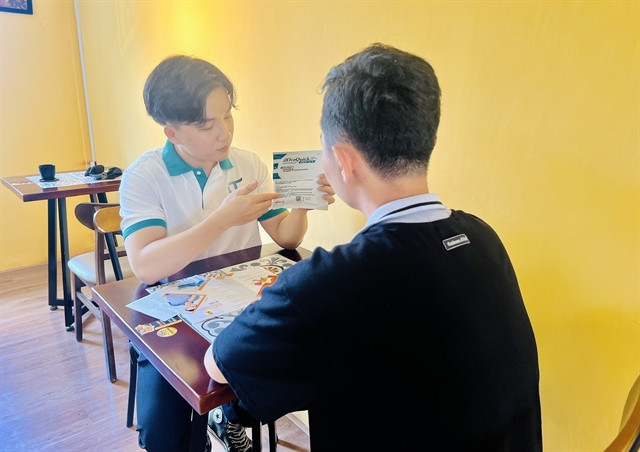This puts Vietnam among the seven countries with the proportion of young peopleamong total new HIV infections higher than the regional and global average –together with Myanmar (53%), Indonesia (48), Thailand and the Philippines (47),Cambodia (43), and Laos (42).
The key population groups are defined by the UN agency as gay men and other menwho have sex with men, sex workers, transgender people, and people who injectdrugs, who are particularly vulnerable to HIV and frequently lack adequateaccess to services.
However, the positive note is the rate does not appear to be on an increasingtrend, according to a UNAIDS Asia Pacific representative at the regional launchof the new global report on Jul 19.
In 2022, there were an estimated 270,000 men who have sex with men, 123,600people who inject drugs, 62,000 female sex workers, and 78,400 transgenderwomen in Vietnam.
HIV prevalence is higher among these key populations. According to the 2022 HIVSentinel Surveillance (HSS) data, HIV prevalence among drug users was 12.1%,among men who have sex with men was 12.5%, among female sex workers was 2.4%,and among transgender women was 5.8%.
However, reports indicate that young key populations are facing challenges inaccessing prevention services, with less than 30% of people injecting drugs,men having sex with men, and female sex workers having inadequate access tothese services.
New infections
It was estimated that there were 5,700 new HIV infections in Vietnam in 2021.
The country would need to cut down annual new HIV infections to equal or below1,000 by 2030 to end AIDS as a public health threat.
According to the Vietnam Authority for HIV/AIDS Control (VAAC), in 2022 therewere about 12,000 people newly diagnosed with HIV. This brings the total numberof people living with HIV who know their HIV status in Vietnam to 222,388, orabout 89% of the total estimated number of people living with HIV in thecountry.
The National Strategy to End AIDS by 2030 set Vietnam for the target of 90% ofall people living with HIV get diagnosed by 2025.
“The trend of new HIV infection across countries in the region differs. In Vietnam,the estimated number of new HIV infections has decreased by 56% between2010-2022. However, we are seeing an increasing number of HIV infections amongMSM in some provinces in the country. This is a red flag. Immediate and smartinvestment in targeted intervention using the “population-location” approach iscrucial,” Dr. Maria Elena F. Borromeo, Country Director of UNAIDS Vietnam told VietNam News.
There were 172,193 people living with HIV on anti-retroviral (ARV) treatment bythe end of 2022, representing 82% of all people with HIV who know their HIVstatus. Further up-scaling of treatment initiation within the same day of HIVdiagnosis can help reduce loss in follow-up and increase enrolment into ARVtreatment.
Vietnam was lauded for the significant increase in pre-exposure prophylaxis(PrEP) use in 2022, with about 51,493 people receiving PrEP at least once, upby 59% from 2021. PrEP is seen as a key strategy for the prevention of sexualtransmission of HIV.
Asia-Pacific situation
The Asia Pacific region was estimated to have about 6,500,000 people livingwith HIV in 2022, making it the second-highest number among all UNAIDS regions.
Last year, approximately 300,000 new infections and 150,000 AIDS-related deathswere reported in the area.
Around 78% of people living with HIV in the Asia Pacific region knew theirstatus in 2022. Of all people living with HIV, 65% were receivingantiretroviral treatment, and 62% had a suppressed viral load.
However, the region did not witness an increase in treatment coverage since2021 and is lagging behind the global treatment average of 76%. As a result,increasing the number of people who know their HIV status, ensuring earlytreatment initiation, and retaining individuals on treatment to achieve viralsuppression and an undetectable viral load are critical priorities for manycountries.
The concept of "Undetectable=Untransmittable" (U=U) applies whenpeople on antiretroviral therapy achieve an undetectable viral load, renderingthem unable to transmit the virus.
The HIV epidemic in the Asia Pacific region disproportionately affects keypopulations and their sexual partners. Compared to the general population, themedian HIV prevalence is 25 times higher for men who have sex with men, 20times higher for people who inject drugs and transgender people, and five timeshigher for people in prisons and sex workers.
Eammon Murphy, Regional Director of the UNAIDS Regional Support Team for Asiaand the Pacific, recommended that countries and agencies focus on HIVprevention programmes and funding for key populations, engage youth-ledorganisations in planning and implementing HIV programmes, make access to PrEPeasier, promote harm reduction, increase access to condoms, and makeself-testing easier to young key populations.
He also urged the removal of human rights barriers by reforming laws andpolicies that hamper young key populations’ access to services, while makingsure to diversify service delivery methods to meet the needs and realities ofyoung key populations./.




























